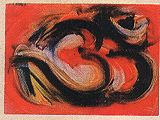



















| Hindu DeitiesGo To Bottom | ||
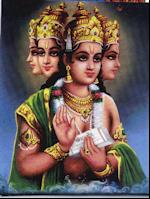 Lord Brahma |
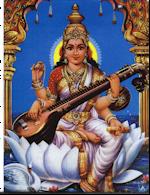 Saraswati |
 Lord Narad |
 Lord Vishnu |
 Laxmi |
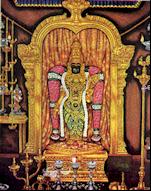 Meenakshi |
 Lord Shiva |
 Durga |
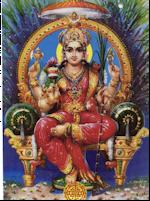 Gauri |
 Lord Ganesha |
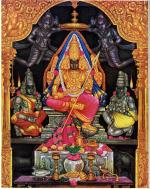 Lord Kartikeya |
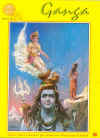 Ganga |
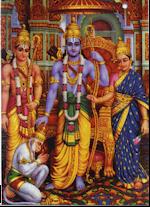 Lord Rama |
 Lord Krishna |
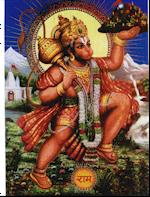 Lord Hanuman |
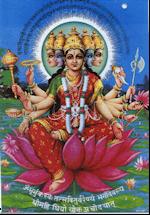 Gayatri |
 Kali |
 OM |
Lord Brahma:
Lord Brahma, the creator God of the Trinity appears seated on a lotus
(a symbol of glorious existence), He has four heads and hands. Each hand is
holding a sacificial tool (sruva), the Vedas (knowledge), a water pot (kamandalu)
and a rosary respectively.His vehicle is a swan (hans) which is known for its
judgment between good and bad. Lord Brahma's consort is Goddess Saraswati,
the Goddess of Learning.
Saraswati:
Goddess Saraswati (Sarasvati) is the wife
(consort) of Lord Brahma and possesses the powesr of speech,
wisdom and learning. She has four hands representing four
aspects of human personality in learning; mind, intellect,
alertness and ego.She has sacred scriptures in one hand and
a lot us (a symbol of true knowledge) in the second. With her
other two hands she plays the music of love and life on the
violin (veena). She is dressed in white (sign of purity) and
rides on a white goose (swan).
Lord Narad:
Narad (Narada) has a lute in one hand and a
pointed knotted tuft of hair in the center of the otherwise
clean-shaven scalp. He plays a subsidiary but very important
role in numerous religious scriptures.According to Mahabharat,
Narad was the son of Kashyap and his mother was one of the
daughters of Daksha. Another account says that he sprang from
the forehead of Brahma. Narad is shown as a wandering seer
going from one place to another. He is reputed to have invented
Veena, the principal stringed instrument of India and is deemed
to be the leader of celestial musicians.He is famous as a
mischief-maker and in India his name is taken as a symbol of
a person who is always creating one or other type of light
mischief for Gods and Goddesses.
Lord Vishnu:
The preserver god of the Trinity has four hands. The first holds a conch shell
(sankha) indicating spread of the divine sound "Om"; one holds a discus (chakra),
a reminder of the wheel of time, and to lead a good life; one holds a lotus (Padma)
which is an example of glorious existence and the fourth hands holds a mace (gada)
indicating the power and the punishing capacity of the Lord if discipline in life
is ignored. His vehicle is the swift-flying bird Garuda which can spread the Vedic
knowled ge with great courage. The dark color of the Lord represents the passive
and formless ether, a great quality for a pervading god. He rests on the bed of the
powerful, coiled serpent, Seshanag who represents the sleeping universe. Lord Vishnu
is also known as Hari, the remover. Lord Vishnu's consort is Goddess Lakshmi, the Goddess
of Wealth.
Laxmi:
She is the consort or wife of Lord Vishnu and is
the goddess of prosperity, purity, chastity and generosity.Her
four hands represent four spiritual virtues. She sits on a
fully blossomed lotus, a seat of divine truth. Her personal
charm is considered par excellence. An aura of divine happiness,
mental and spiritual satisfaction, and prosperity always exist
around her.Her palm is always extended to bless people.
She is adored by Lord Ganesha
Meenakshi:
Sri Meenakshi Devi is the incarnation of
Parashakti. The sthala purana has it that the King Malaya
Dhwaja, a great devotee of Lord Shiva was childless and
hence conducted puthra kameshti yagna. Goddess Parvathi
was born and named as Meenakshi (Her eyes being in the shape
of fish).Meenakshi was a great devotee of Lord Sundareswara
(Shiva) and the Lord comes in disguise followed by many
thrilling episodes known as (sixty four tiruvilayadals),
before manying the goddess Meenakshi. Many poets adorned
the court of Pandya Kings and Madurai was the seat of Tamil
literature. It was also popularly known as the birthplace
of Tamil Sangam.Shri MEENAKSHI (Madurai --Tamil Nadu) :
Madurai is about 492 Kms. from Madras. This town is famous
for Goddess Meenakshi temple and was capital of Pandya Kingdom.
Lord Shiva:
Lord Shiva appears in a meditating but ever-happy posture. He has matted hair
which holds the flowing Ganges river and a crescent moon, a serpent coiled around
his neck, a trident (trishul) in his one hand and ashes all over his body.The Lord's
attri butes represent his victory over the demonic activity, and calmness of human
nature. He is known as the"giver" god. His vehicle is a bull (symbol of happiness and strength) named Nandi.
Shiva-Linga, a sign of the Lord, is adored instead of him. Shiva temples have
Shiva-Linga as the main deity
Durga:
Goddess Durga, also known as Parvati or Lalitha is
the wife (consort) of Lord Shiva and exists in various divine
(both friendly and fearful) forms. Two of her fierce but very
powerful forms are Durga (goddess beyond reach) and Kali
(goddess of destruction).Both have eight hands and great power
and energy (Shakti). Durga rides on a lion and Kali rides on
a corpse of a demon. Parvati was called Sati in her previous
divine incarnation. The family of Lord Shiva, Parvati and their
sons Ganesha and Kartikeya is an ideal example of family unity
and love.She has a charming personality. She is adored by
married women for a happy married life.
Gauri:
Gauri represents purity and austerity. She is the
Kanya (young, unmarried) Parvati who had undergone severe
penence in order to get Lord Shiva as her husband. Sita,
the consort of Go To Top
Lord Ganesha:
Hindu dharma accepts the existence of several Gods
or deities, it accepts only one God, the Supreme.Brahma,
Vishnu and Siva. are not three independent and separate
deities, but three different aspects of the same Supreme God,
while engaged in the processes of creation, sustenance and
destruction of the universe, in that order. It is similar to
the role played by the same person as the father at home, as
the boss in the office and as a customer in a shop. Other
deities also should be considered in the same light, as
different aspects of the Supreme God, manifesting themselves
for specific purposes.The powers of these deities which are
inseparable from them - just as the power of fire to burn
cannot be separated from fire itself. This power is
conceived in the form of their consorts, Sarasvati, Parvati
(or Sakti) and Lakshmi.This is not to say that these deities
are imaginary creations. All of them, without exception, are
different modes and aspects of Paramatman, the Supreme Self or
God
Lord Kartikeya:
Kartikeya, the second son of Lord Shiva, and Goddess
Parvati is also known as Subramaniam, Skanda, Guha, Shadannana or
Sanmukha (because he has six faces).He represents a person of perfection.
He is the war God, the Hindu equivalent of Mars and Ares. He was created
by all the Gods to lead the heavenly hosts and destroy the demons. He is the
most masculine and fierce of all the Gods. He is also fire, Agni and is very
Pitta (fiery) in nature. While Ganesh removes all obstacles, Skanda bestows
all spiritual powers, particularly the power of knowledge.In one hand he carries
a spear called sakti which symbolizes the destruction of negative tendencies
in humans. With his other hand he always blesses devotees.The Lord's vehicle is
a peacock which is capable of destroying harmful serpents (symbolizing harmful
ego and bad desires of people).
Ganga:
Ganga The Goddess Ganga, representing the river Ganga (Ganges) is shown
white in color, wearing a white crown, sitting on the sea animal crocodile, holding
in her right hand a water lily and in her left hand a lute.Rig Veda mentions the name
Ganga only twice but in the later Puranic period, Ganga assumes great importance as
a Goddess. She is called Mandakenee in the heaven and Bhagirathi in patal.
Purans declare that the sight, the name and the touch of Ganga takes away all
sins and that bathing in Ganga bestows blessings of the highest order. The cremation
of a dead body at the banks of Ganga and the immersion of the remains of a dead in its
water after cremation elsewhere is considered propitious. Gangajal, the water of
Ganga, is very sacred, and is used for many pujas (religious ceremonies). Those who
die within specified limits of Ganga, called Gangakshetra (the land of Ganga), are
believed to go to the heavenly world and all their sins washed away.The other sacred
rivers for Hindus are, Yamuna, Saryu, Sindhu, Godavari, Kaveri, Narmada, Gomti, and
Brahmaputra.
Lord Rama:
Lord Rama is one of the most commonly adored gods of Hindus and is
known as an ideal man and hero of the epic Ramayana.He is always holding a bow
and arrow indicating his readiness to destroy evils. He is also called "Shri Rama".
More commonly he is pictured in a family style, (Ram Parivar) with his wife Sita,
brother Lakshman and devotee Hanumanwho is sitting
near Lord Rama's feet.
Lord Krishna:
Because of his great Godly power, Lord Krishna is another of the most
commonly worshipped deities in the Hindu faith. He is considered to be the eighth
avatar of Lord Vishnu. Shree Krishna delivered Bhagwad Gita on battlefield to Arjun.
He, like Lord Rama, is also known for his bravery in destroying evil powers
throughout his life. The Lord is usually depictted as play ing the flute (murali),
indicating spread of the melody of love to people. He is also shown with his
childhood devotee Radha. The Lord is usually remembered and worshipped as
Radha-Krishna. The pair symbolizes the eternal love between people and god.Lord
Krishna is also shown with his pet cow, his childhood favorite. Lord Krishna
performed many divine sports (leela) as a child
Lord Hanuman:
Hanuman is a monkey god. He is a noble hero and great devotee of
Lord Rama of the Ramayana. This deity is a provider of courage, hope, knowledge,
intellect and devotion. He is pictured as a robust monkey holding a mace (gada)
which is a sign of bravery and having a picture of Lord Rama tatooed on his chest
which is a sign of his devotion to Lord Rama. He is also called Mahaveera.
(the great hero ) or Pavan-suta (son of air) or Bajarangbali.
Gayatri:
Gayatri is the name of one of the most important
Vedic hymns consisting of twenty-four syllables This hymn is
addressed to Lord Surya (Sun) as the supreme generative force.
The hymn says, "We meditate on that glorious light of the
divine Surya, may he, the lord of light illuminate our minds".
One of the sacred texts says, "The Gayatri is Brahma, Gayatri
is Vishnu, Gayatri is Shiva, the Gayatri is Vedas" Gayatri
later came to be personified as a Goddess. She is shown as
having five heads and is usually seated within a lotus. The
four heads of Gayatri represent the four Vedas and the fifth
one represents almighty God. In her ten hands, she holds all
the symbols of Lord Vishnu. She is another consort of
Lord Brahma.
Kali:
Goddess Kali is another form of Goddess Durga or
Parvati.Shree KALIMATHA (Calcutta West Bengal) temple known
as Kalighat Temple situated in Calcutta is one of the 52 Sakti
Peetas of india. It is situated in Alipore about 5 miles from
Howrah. There is always a big crowd of devotees from all over
the country to worship the Kali Mata. The poojas and other
festivals of light, crackers and colorful processions connected
with Navaratri celebrations are hallmarks and highlights of
the festivals conducted in honor of the Goddess Kali.
OM:
The mantram Aum denotes God as the Primal Sound. This sound can be
heard as the sound of one's own nerve system, and meditators and mystics hear it daily, like the sound made by an
electrical transformer or a swarm of bees, or a thousand vinas playing in the distance. It is a strong, inner
experience, one that yogis hold with great reverence.The meditator is taught to inwardly transform this sound
into the inner light which lights up ones' thoughts,and to bask in this blissful consciousness of light.
Literally, Pranava in Sanskrit means "humming." Pranava is also known as the sound of the nadanadi sakti.
Hearing it one draws near to God Consciousness. When we are living in the lower chakras, or when the world too strongly
dominates our mind, this sound may, for a time, not be heard. But it returns as awareness withdraws, as the mind becomes
perfectly quiescent, silent, still. Listen for this sound in your quietest moments and you will learn to recognize it as a
daily encounter with the Divine that lives within all men,
within all creatures, within all existence. Aum Namasivaya!
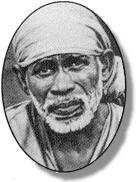
Shri Shirdi Sai Baba
Visit Sai Baba Site
Back
Home
Top
 and
and 
| Home Page | Family | Education | Friends | Photographs |
|---|---|---|---|---|
| Bio-Data | Hindu Gods & Religion | Come to Animal Kingdom | ||
| Important information for You | Contact | Guest Book | ||